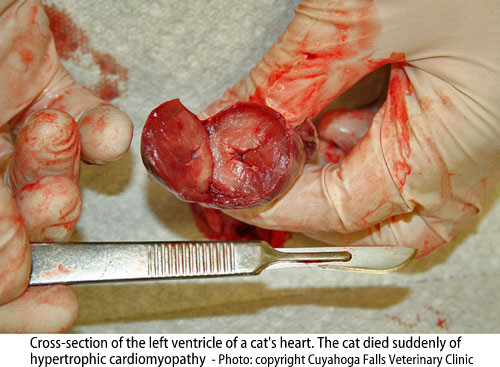
The reason why I am writing this is because a person (who I will keep anonymous) wrote to me about their cat. He was three years old and he died very suddenly overnight. Late in the evening he was fine but had been dead for a while when he was seen the next morning. He had been fed Purina One Cat Adult Chicken and Rice cat food. He was concerned about the food and whether it might have contributed to the death.
The photograph above is of a cross-section of a cat’s heart diseased by hypertrophic cardiomyopathy (HCM) – not the heart of the cat referred to in the opening paragraph. The cat’s owner wanted to find out the cause of death. The photograph was taken by the staff at the Cuyahoga Falls Veterinary Clinic. This photo has been used with permission for teaching/educational purposes at PoC. I want to thank Ryan G. Gates, DVM of the clinic for granting permission. If people want to use the picture please ask the clinic first.
HCM is the most common cause of heart disease in cats. It is also the common cause of spontaneous death in full-time indoor adult cats. The walls of the ventricles thicken and the muscle fibers are replaced by scar tissue. The heart is weakened because the heart wall becomes less elastic and the chamber smaller.
Increased heart rate, heart murmur, loss of appetite, increased respiratory rate might be signs. However sometimes the “first and only sign may be sudden death”. Early symptoms are vague and unclear. Also cats are good at restricting their physical activities to meet their abilities, which in the case of heart disease will be limited. This makes the disease harder to spot.
In purebred cats the Bengal cat is known to be predisposed. Other breeds are also predisposed including the ever popular Maine Coon – see MC health problems. Other purebred cats that can inherit this disease are Ragdolls, British SHs, American SHs, and Devon Rexes. The disease usually affects cats from 1-5 yrs of age but it can affect kittens of 3 months-of-age and older cats at 10 years-of-age.
In male Maine Coons signs of the disease may show when the cat is 2 years old and for females at 3 years-of-age. Ragdolls can show signs at aged one.
For Maine Coons and Ragdolls the cause is a genetic mutation described as a “genetic defect” which involves the myosin Binding Protein C in the heart muscle. It is believed that 25-33% of Maine Coons carry this defective gene. It is autosomal dominant (not linked to the cat’s gender). Cheek swab and blood tests are available at, for example, the Veterinary Cardiac Genetics Laboratory at Washington State University College of Veterinary Medicine. Breeders of Maine Coons should and almost certainly do test their breeding cats to eliminate cats with the defective gene from their breeding programs.
Low-salt diets such as Hill’s Prescription Diet Feline h/d or Purina’s CV Cardiovascular are recommended by some vets for cats with HCM. However, a minority of other vets might argue that “prescription diets” are not what they are trumped up to be especially as they are dry foods which are generally recognized today as causing problems of their own. There are other treatments for a cat with HCM including drugs such as beta blockers, ACE inhibitors, diuretics, aspirin and calcium channel blockers. Less strain on the cat and rest can prolong life.
Not feeding a deliberately low-salt diet might have an impact on the longevity a cat with HCM but bearing mind there are other factors such as whether the disease has been spotted or not, the benefits of a prescription diet may be limited even if it is wet food. You might know that a low salt diet is also recommended for humans with high blood pressure.


Michael thanks for this excellent article.Seems cats and humans have some identical health problems.My 22 year old Alexandrine parakeet “Mittoo” died from a “Heart attack”.
Thank you Michael, for sharing this information. This is my “go to” place for much of my cat education, in addition to the research I do, which I share with you.
Michael, thank you for this informative article. I had a cat pass from HCM 2012. Yes, it was quite a shock as he was only 5-1/2 years old at the time. He (and his sisfur whom I still have) were feral rescues, so who knows their lineage or background history. I didn’t know much about this disease until the last year. But Luke was a wonderful boy who loved to be groomed — at the groomers or with a brush at home. His sisfur Leia is still with me and will have her 9th birthday on May 18th. . . ♥♥♥
Bless his memory. It is just bad luck. I am pleased you found it useful. The percentage of Maine Coons with the HCM defective gene is high and at similar percentage as Persian cats developing an entirely different disease Polycystic Kidney Disease.